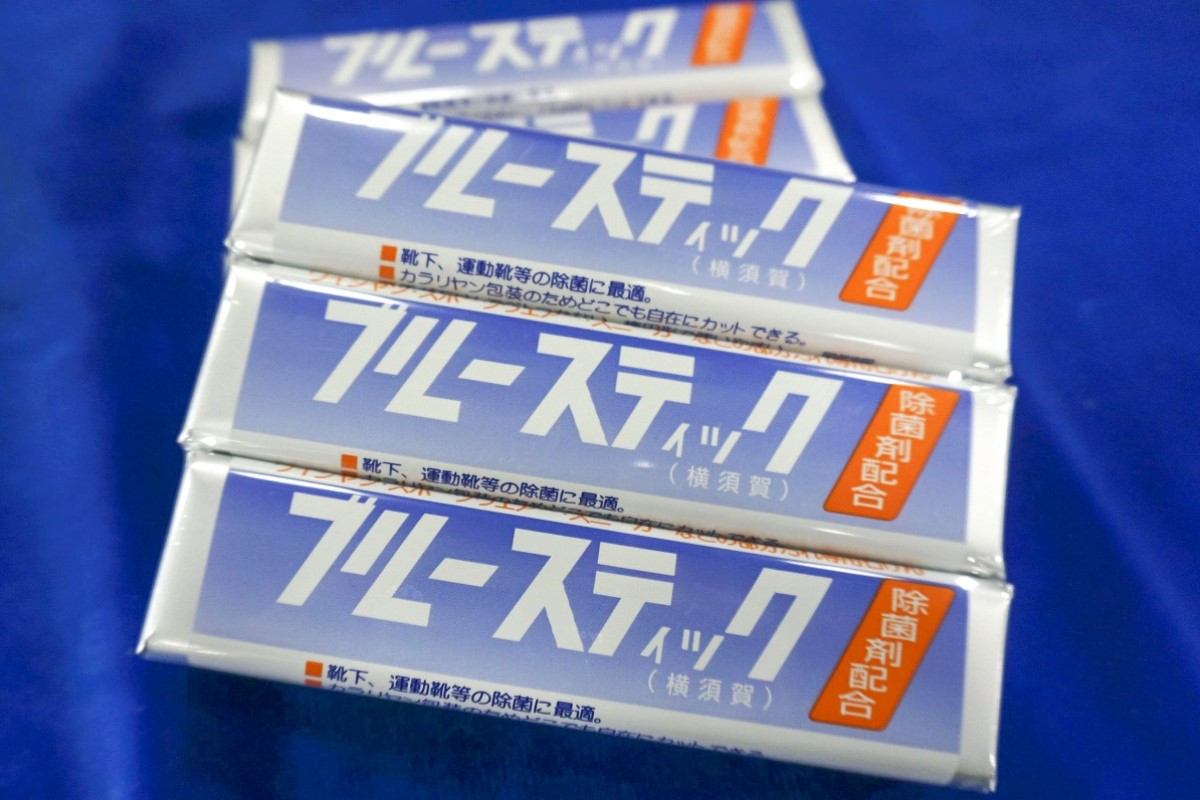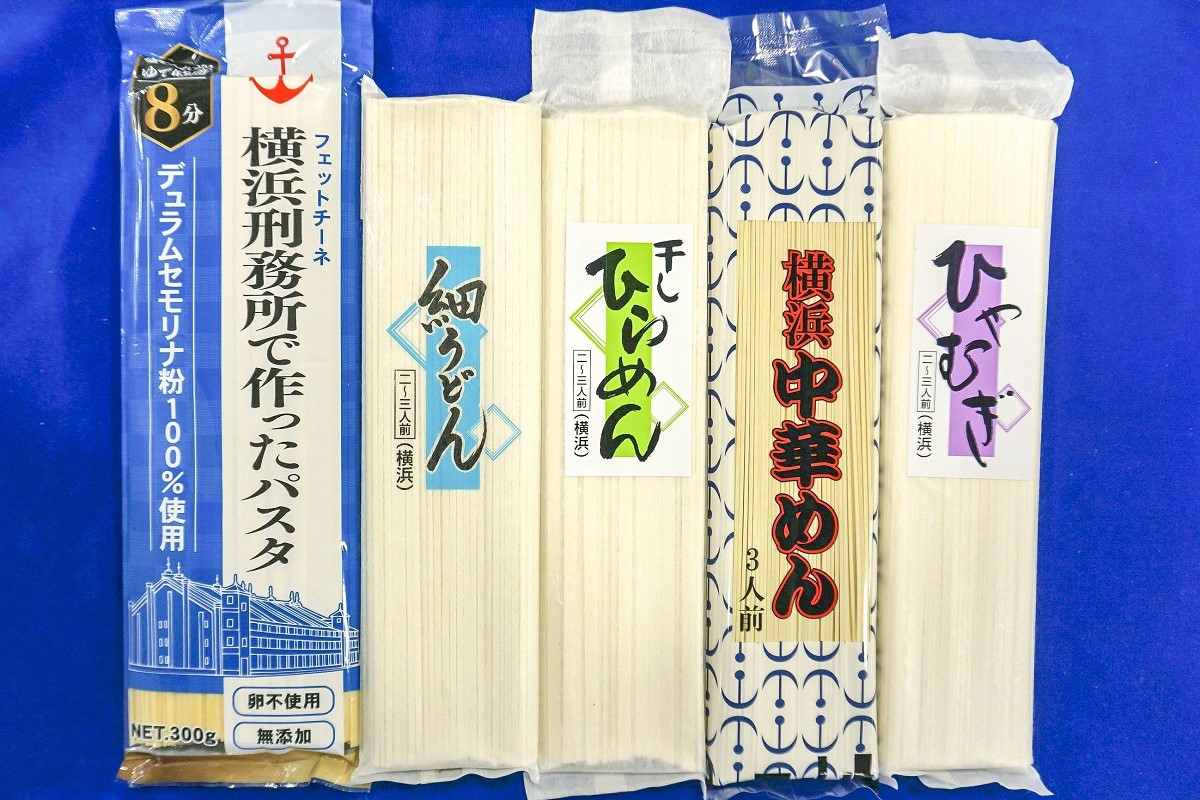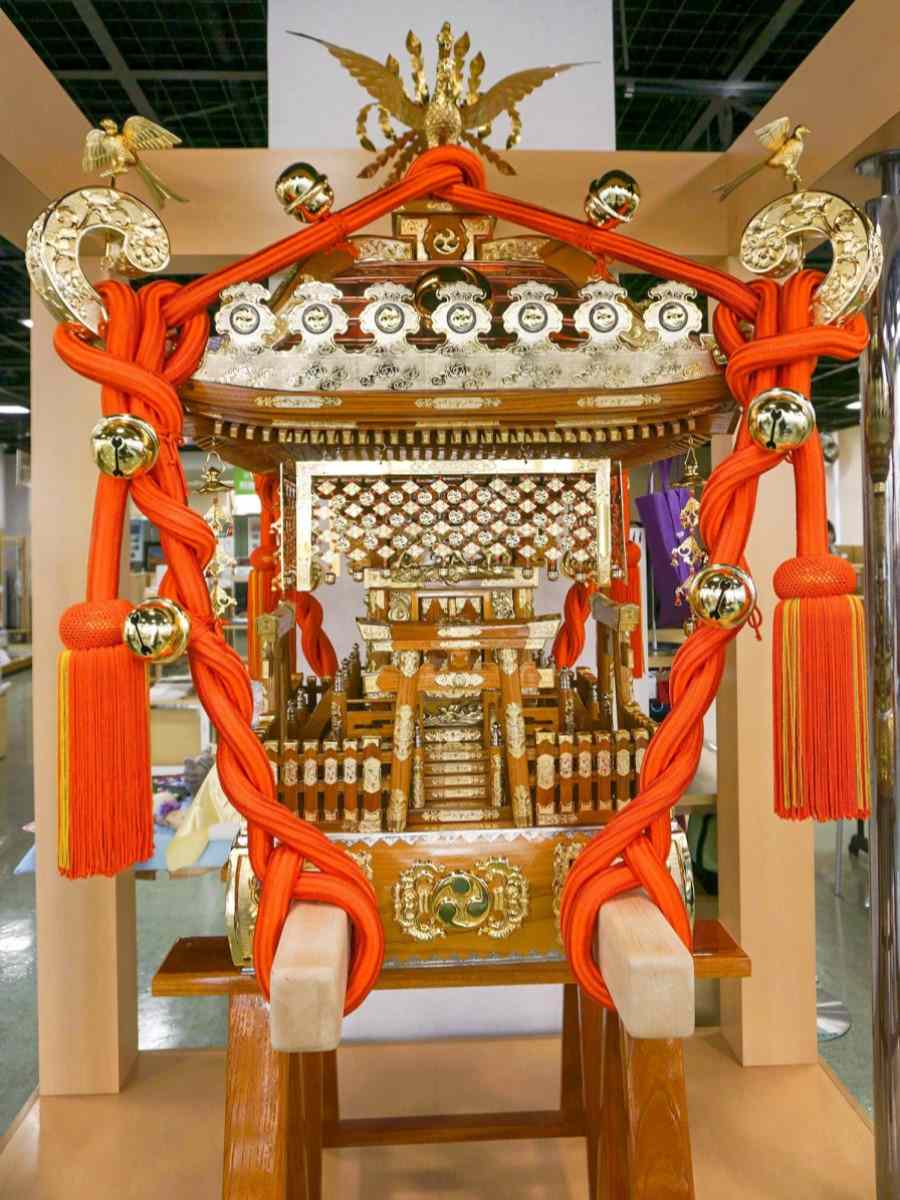Prison Inmates Make 4,000 Products, Including Best-selling Laundry Soap Bar; Labor System to Change in 2025

Blue Stick laundry soap bars made at Yokosuka Branch Prison
6:00 JST, May 8, 2024
Prison inmates are required by law to do labor while serving their sentences.
About 4,000 products are made by inmates including items such as pasta and tote bags that are expected to meet consumers’ tastes. Among other products, a simple laundry soap bar sells well because of its good quality and low price.
Popular ‘Blue Stick’ soap
Called Blue Stick, the laundry soap bar is 14 centimeters long and weighs 150 grams. The product has earned a reputation for removing stubborn stains from gym clothes and socks with only a light rubbing, and it is by far the best-selling product on a direct sales website and in special stores in annexes at prisons. The catchphrase “Superstar of stain removal” written on its packaging is no exaggeration.
The soap is made by inmates at Yokosuka Branch Prison. It costs ¥500 including tax for a set of three. About 88,000 sets, or about 260,000 units, were sold nationwide between April last year and January this year. The product is so popular that it is being resold on the internet at three to four times the regular price.
When asked why it removes stains so well, Yukio Kono, 45, a former deputy director of the branch, dodged the question and said with a smile: “It’s a trade secret.” He also said: “Inmates feel rewarded when they hear about its popularity.”
The Penal Code requires inmates sentenced to imprisonment to do prison labor. As of the end of March last year, about 33,000 inmates were engaged in such work and about 1,200 of them were involved in making products for sale to the public.
There are about 4,000 kinds of products including bags, men’s shoes and the memorably named “Pasta made in Yokohama Prison.”
Sales in recent years have decreased for expensive furniture with woodworking done by inmates. In addition, sales exhibitions of products prisoners make were canceled due to the coronavirus pandemic. Sales have dropped to about one-third compared to 20 years ago but still totaled about ¥598 million in fiscal 2022. The proceeds are used to pay for product materials and subsidize crime victim support groups.

Dried noodles made at Yokohama Prison
Inexpensive labor
Prison labor is said to have originated at a detention facility called “ninsoku yoseba,” which was set up at the mouth of the Sumida River in Edo, the old name for Tokyo, in 1790 during the Edo period (1603-1867). The facility primarily accommodated people who had been removed from family registers and were believed to cause public disorder, and it provided them with vocational training such as carpentry and blacksmithing.
In the Meiji era (1868-1912), the penal system was gradually developed. Inmates made bricks, for example, which contributed to Japan’s modernization. A distinctive feature was labor performed outside prisons, such as working on development projects in Hokkaido and mining in the Miike coal mine in Fukuoka Prefecture. The work was done under harsh conditions, which resulted in many casualties and more than 1,000 escapees a year.
After the Manchurian Incident in 1931, prison labor turned to the production of military goods. Many men going off to war caused a labor shortage, and some inmates were tasked with making combat boots and wooden boxes to hold ammunition. Those engaged in shipbuilding were seen as standout laborers, who were, according to a record, flattered by a high-ranking justice ministry official as “industrial warriors behind the lines.” Until that time, prisoners were considered to be cheap labor.
After World War II, prison labor began to focus on education for rehabilitation and reintegration into society for inmates to prepare for their release from prison. New products were created one after another to meet the needs of the times.
No longer obligatory
The prison labor system will change dramatically in June next year. The revised Penal Code will usher in a new imprisonment system that focuses more on rehabilitation than punishment.
Under the system, prison labor will no longer be obligatory and it will be possible for prisons to implement various other programs more flexibly, such as giving drug addicts a more focused correctional program and providing elderly inmates with physical therapy so they stay fit. The system will also train inmates to form better social ties and improve their communication skills to prepare for their release.
Prisons will no longer have to secure up to eight hours a day for inmate labor and instead can spend more time providing correctional programs as needed. However, what will be the effect on the products that inmates make?
“It’s true that the amount of work will decrease,” said Manabu Nakajima, a professor at Fukuyama University and specialist in criminal policy, “but more attractive products will be created as inmates participate in planning them and collaborating with various people in society.”
Making traditional crafts
Inmates in some cases have become key players making traditional crafts in industries that are suffering due to a lack of successors.
A typical example is “Sakai-style handwoven dantsu,” a rug-weaving technique that has been handed down in Sakai, Osaka Prefecture since the Edo period. The technique is used to make rugs with delicate patterns and dignified appearances, but use of the technique has declined in recent years due in part to mechanization.
Concerned that the technique could disappear, a local association dedicated to preserving it asked Osaka Prison to include the technique in its vocational training program. It was added to the prison’s labor program in 1994.
According to the Sakai City Museum, all products created using the technique and sold to the public currently are made by prison inmates, not by the several weavers who belong to the association.
According to the Justice Ministry, some prisons make traditional crafts that are specially designated by the government.
Five prisons are involved in the program including Aomori Prison making Tsugaru lacquerware, Yamaguchi Prison making Hagi ceramics and Okayama Prison making Bizen pottery. Inmates learn the techniques from specialist legal technical officers and experts in the fields who are specially invited from outside to train them. The tasks were included in prison labor around the 1980s.

A festival float that was made at Toyama Prison
The ministry says that doing the work is also intended to give inmates a sense of accomplishment and success.
There is no confirmed evidence that any former inmates have become professionals of the traditional crafts after their release from prison. However, Okayama Prison, which accommodates those serving sentences of 10 years or more, says that some inmates have acquired skills almost equal to those of professional Bizen ware artisans.
"Society" POPULAR ARTICLE
-

M4.9 Earthquake Hits Tokyo, Neighboring Prefectures
-

Israeli Tourists Refused Accommodation at Hotel in Japan’s Nagano Pref., Prompting Protest by Israeli Embassy and Probe by Prefecture
-

M7.5 Earthquake Hits Northern Japan; Tsunami Waves Observed in Hokkaido, Aomori and Iwate Prefectures
-

Tsukiji Market Urges Tourists to Avoid Visiting in Year-End
-

High School in Kyoto Says Students Shoplifted during Recent School Trip to Bali, Indonesia
JN ACCESS RANKING
-

Tokyo Economic Security Forum to Hold Inaugural Meeting Amid Tense Global Environment
-

Keidanren Chairman Yoshinobu Tsutsui Visits Kashiwazaki-Kariwa Nuclear Power Plant; Inspects New Emergency Safety System
-

Imports of Rare Earths from China Facing Delays, May Be Caused by Deterioration of Japan-China Relations
-

University of Tokyo Professor Discusses Japanese Economic Security in Interview Ahead of Forum
-

Japan Pulls out of Vietnam Nuclear Project, Complicating Hanoi’s Power Plans























